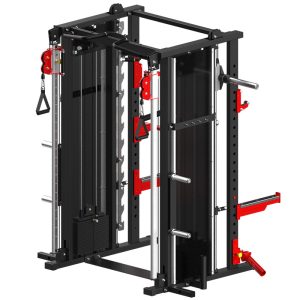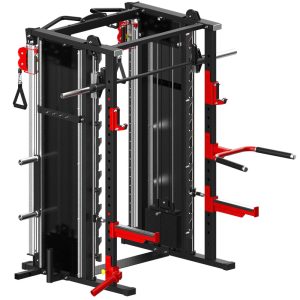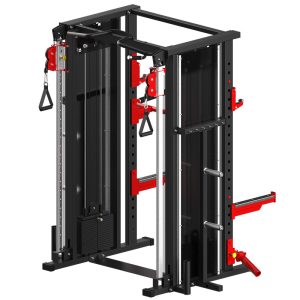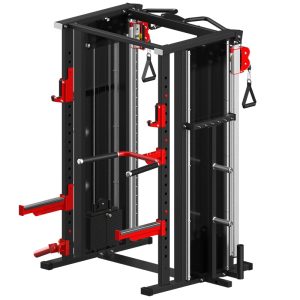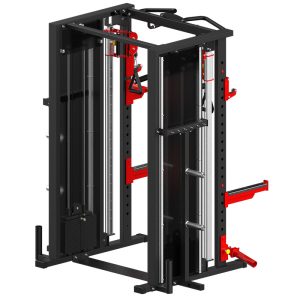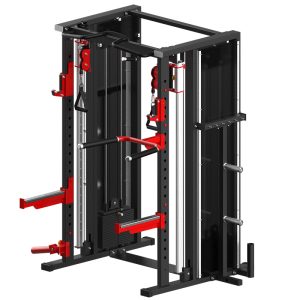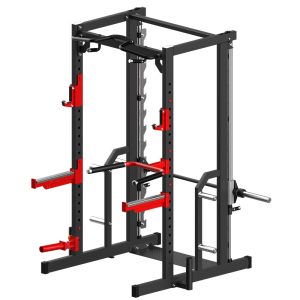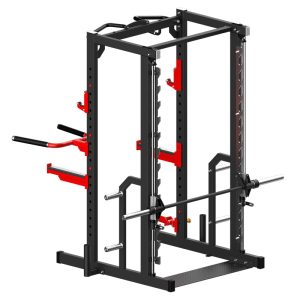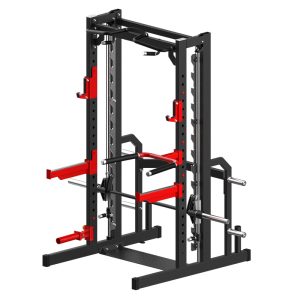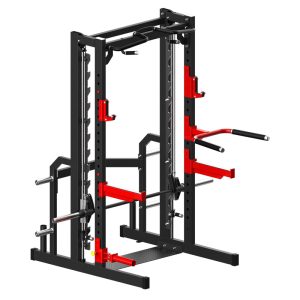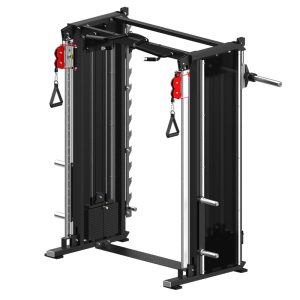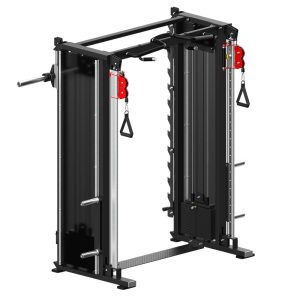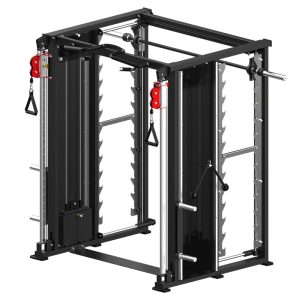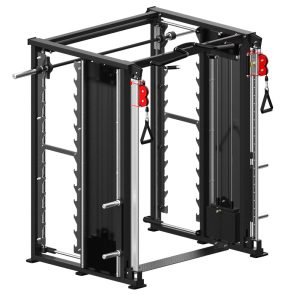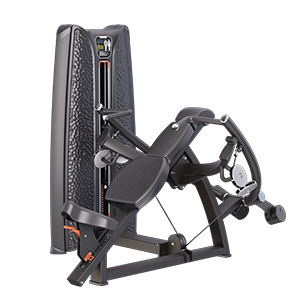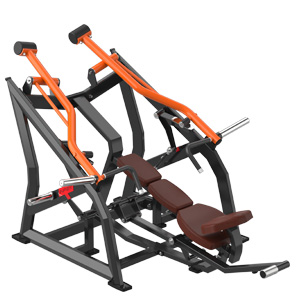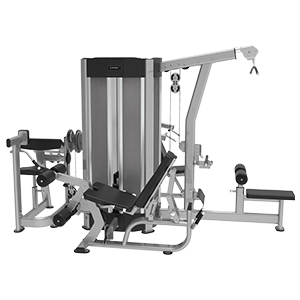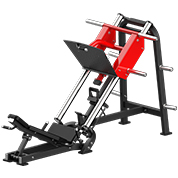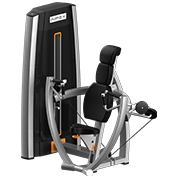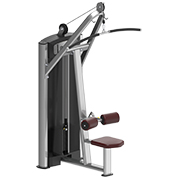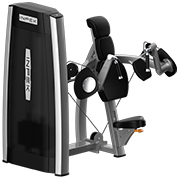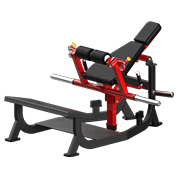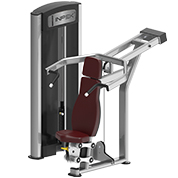- Home
- /
- Multi Function Gym Machines
Best Multi Function Gym Machines for Comprehensive Workouts
Commercial Multi Station Gyms by Inpek Fitness are versatile, space-saving workout solutions designed to deliver a full-body exercise experience in one compact unit. Each multi-function machine combines various workout stations and functionalities, allowing users to target multiple muscle groups efficiently without the need for numerous pieces of equipment. Key features include adjustable seats, multiple attachment points, and integrated weight stacks, facilitating a smooth transition between strength training, functional fitness, and cardio workouts. Inpek Fitness’s Multi Function Gym Machine range includes: Comprehensive Training Machines: The Flying Bird 3D Smith Comprehensive Training Machine and the Squat Smith Comprehensive Training Machines (both single- and dual-sided versions) enable a wide range of exercises. These setups offer extensive workout versatility, from squats and presses to assisted full-body movements, making them invaluable for dynamic strength routines. Squat and Hip Trainers: The Squat Flying Bird Comprehensive Training Machines (available in single and dual-sided configurations) and the Hip Multi-function Training Station (Basic and Professional Editions) are crafted to support lower body strength and hip-focused exercises. These machines are designed to engage the glutes, hips, and thighs, making them ideal for users focused on lower-body conditioning. Adjustable and Multi-Use Equipment: The Multi-purpose Adjustment Chair, Hip Plate-Mounted Hip Trainer, and Hip Bridge Squat Rack offer users adjustable and versatile workout options, allowing for targeted strength building across various muscle groups. These pieces support customizable exercises that suit users of different fitness levels and sizes. Inpek Fitness’s multi-station gym machines are designed for optimal space efficiency, making them a perfect fit for commercial gyms aiming to maximize square footage without sacrificing functionality. This adaptability encourages diverse workout routines, enhances fitness results, and reduces workout monotony. By combining multiple exercise options into a single machine, these multi-function setups provide a cost-effective alternative to purchasing individual equipment, making it easier for gym owners and users alike to invest in comprehensive fitness solutions.
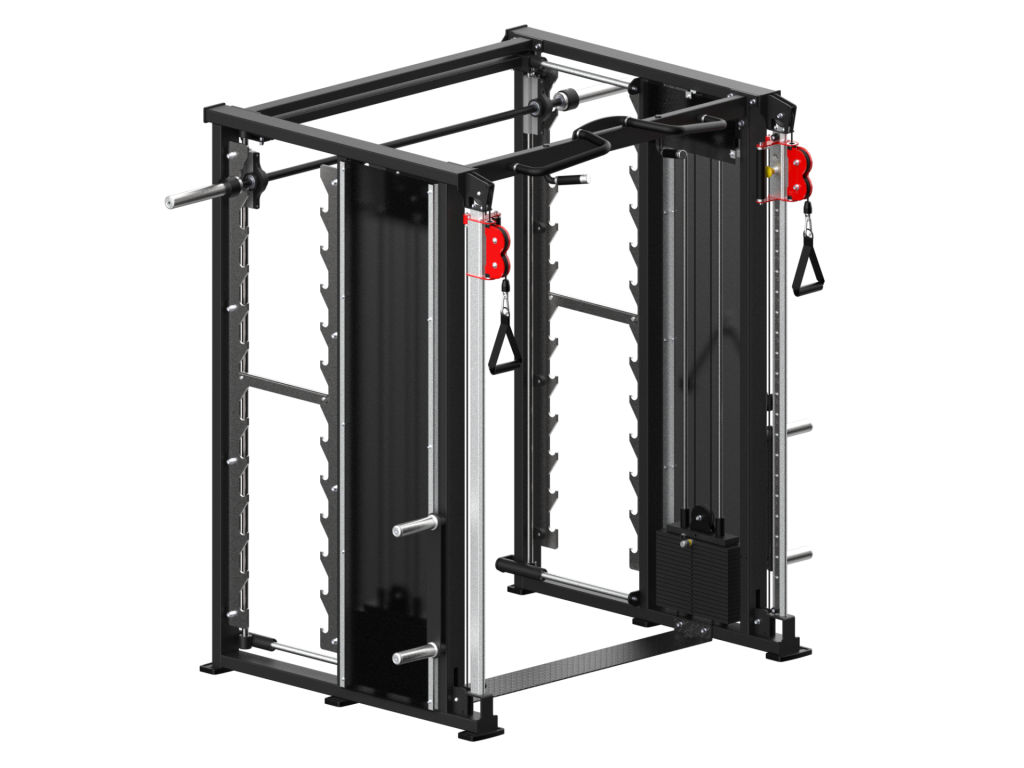
K19 Functional Smith Series
The K19 Functional Smith Series is an perfectly combination of Smith, Squat, and Dual Pulley, which can exercise all muscles in the body, including the six major muscle groups, and can train more than 100 movements. The product design features smooth lines and is durable, meeting the needs of various venues.

Commercial Multi Station Gym Equipment
Description of Commercial Multi-Station Gym Equipment
Designed for heavy use in fitness facilities, making it suitable for high-traffic environments like gyms and health clubs.
Offers versatility for various exercises, enabling users to target multiple muscle groups simultaneously. This is particularly beneficial for maximizing space and providing a comprehensive workout experience with machines like the multi functional trainer, which combines several stations into one.
Key Features to Look For
Space Requirements:
Before making any purchase, accurately measure the available space in your gym, including both floor area and ceiling height. This ensures that the equipment you select fits appropriately and allows for safe movement around the stations. Consider not only the equipment’s footprint but also the necessary clearance for users to perform exercises without obstruction. Planning the layout effectively can optimize the flow of your gym, making it more inviting and functional.
Number of Users:
Consider the expected number of users who will be utilizing the multi-station gym at any given time. Choosing stations that accommodate multiple users simultaneously can enhance the overall efficiency of your gym. This is especially important during peak hours when many clients are trying to access equipment. Look for multi-station gyms designed to allow for parallel workouts, which can significantly improve user satisfaction and retention.
Exercise Options:
Ensure that the multi-station gym provides a diverse range of exercise options that target various muscle groups. Stations should be capable of supporting multiple types of workouts, from strength training to functional movements. Equipment that includes features for both upper and lower body exercises will cater to a broader audience and encourage users to engage in comprehensive training routines. Additionally, consider the inclusion of attachments or accessories that can further enhance workout variety.
Weight Capacity:
A critical factor in your selection should be the weight capacity of the machines. Make sure the equipment can accommodate users of all fitness levels, including those who may require heavier weights for effective training. This ensures that your gym is accessible to everyone, from beginners to advanced athletes, and supports a wide range of training goals. Look for multi-station gyms with adjustable weight stacks that can be easily modified for different users.
Build Quality:
Investing in durable, high-quality materials is essential for the safety and longevity of your multi-station gym. Equipment should be constructed to withstand rigorous use over time without compromising performance. Materials such as heavy-duty steel frames, high-quality upholstery, and wear-resistant finishes will ensure the equipment remains reliable and visually appealing, ultimately reducing long-term maintenance costs.
Adjustability:
Look for customizable components that allow users to adjust the equipment to fit their preferences. Features such as adjustable seats, handles, and weight settings can greatly enhance user comfort and effectiveness during workouts. By accommodating a variety of body types and training styles, adjustable multi-station gyms can improve user satisfaction and engagement.
Maintenance:
Consider the maintenance requirements of the multi-station gym you are purchasing. Opt for equipment that is designed for wear resistance and ease of serviceability. Machines that are simple to clean and maintain will save time and effort in the long run, ensuring that your gym remains in top condition and minimizing downtime due to repairs. Look for warranties and service options from the manufacturer to support ongoing maintenance needs.
Small Commercial Multi Function Gym Machines
Definition and Benefits of Small Commercial Multi-Function Gym Machines
Small commercial multi-function gym machines are compact fitness solutions designed to accommodate a variety of exercises in limited spaces. Their design allows users to perform multiple exercises without requiring separate machines for each movement, making them an efficient choice for any fitness facility.
Ideal for Limited Spaces in Gyms or Fitness Centers
The compact nature of small commercial multi-function gym machines makes them ideal for environments with limited square footage. They maximize workout potential while minimizing the footprint, allowing gym owners to offer a diverse range of training options without overcrowding the space. For example, a multi functional trainer can combine features such as cable pulleys, leg presses, and free weight options into one versatile machine, enabling users to engage in full-body workouts without needing extensive equipment.
Discussion on Their Effectiveness in Providing a Full-Body Workout
Small commercial multi-function gym machines are highly effective for providing full-body workouts. By incorporating various exercise stations, such as those found in a multi functional trainer, users can target all major muscle groups efficiently. These machines often include features for strength training, functional movements, and flexibility exercises, allowing for comprehensive training in a single session. The ability to perform compound movements, such as squats, presses, and rows, promotes muscle engagement and cardiovascular conditioning, making these machines suitable for individuals of all fitness levels. As a result, small commercial multi-function gym machines not only save space but also enhance the overall workout experience, helping users achieve their fitness goals effectively.
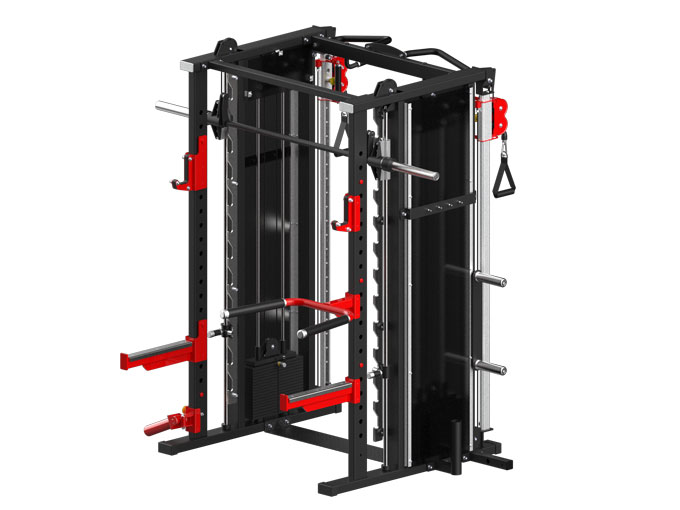
Collaborate with Inpek Fitness Experts for Your Commercial Gym Projects
Looking to enhance your gym with premium equipment? Have inquiries or ideas? Complete the form below to engage with our expert team. We’ll work with you to realize your fitness facility goals efficiently and effectively.
FAQs about Multi Function Gym Machines
Is a Multigym better than free weights?
The comparison between a multigym and free weights often depends on individual fitness goals and preferences. A multigym offers the advantage of guided movements, which can be beneficial for beginners who are learning proper form and technique. It typically includes multiple stations that allow users to perform various exercises, targeting different muscle groups within a single machine. This versatility can lead to more efficient workouts, especially in a limited space. On the other hand, free weights, such as dumbbells and barbells, engage stabilizing muscles and promote functional strength, which can be advantageous for overall athletic performance. Free weights also allow for a broader range of motion, helping to develop coordination and balance. Ultimately, whether a multigym is better than free weights will depend on personal goals, experience level, and workout preferences. Many fitness enthusiasts find that incorporating both into their routines yields the best results.
What muscles does a multi gym work?
A multi gym is designed to target a wide range of muscle groups through its various stations and exercises. Common exercises performed on a multi gym include chest presses, lat pulldowns, leg extensions, and seated rows. These exercises primarily work the following muscle groups:
Chest: The chest press and pec fly stations primarily target the pectoral muscles.
Back: Lat pulldowns and seated rows effectively engage the latissimus dorsi and trapezius muscles.
Legs: The leg extension, leg press, and leg curl stations work the quadriceps, hamstrings, and calves.
Shoulders: Shoulder presses and lateral raises target the deltoid muscles.
Arms: Bicep curls and tricep extensions focus on the arm muscles, promoting strength and definition.
Overall, a multi gym provides a comprehensive full-body workout, making it an efficient choice for individuals looking to enhance strength across multiple muscle groups.
What is the difference between a multi gym and a power gym?
The main difference between a multi gym and a power gym lies in their design and intended use. A multi gym is a versatile piece of fitness equipment that typically includes multiple exercise stations, allowing users to perform a wide variety of strength training exercises in one compact machine. It is designed for general fitness and can target multiple muscle groups through guided movements. On the other hand, a power gym, often referred to as a power rack or power cage, is primarily focused on heavy lifting and compound movements, such as squats, bench presses, and deadlifts. Power gyms provide a more open design, allowing users to perform free weight exercises with added safety features, such as safety bars and adjustable height settings. While both types of equipment can be effective for building strength, a multi gym is generally more suited for those seeking a variety of exercises in a smaller footprint, whereas a power gym is ideal for serious weightlifters looking to focus on heavy lifting.
Are multi gyms effective?
Yes, multi gyms are effective tools for strength training and can help individuals achieve their fitness goals. They provide a comprehensive workout by allowing users to perform multiple exercises targeting various muscle groups in a single machine. This versatility can lead to improved muscle strength, endurance, and overall fitness. Multi gyms often include guided movements, which can enhance safety and ensure proper form, particularly for beginners. Additionally, they can accommodate users of different fitness levels by offering adjustable weight settings, making it easy to progress over time. However, the effectiveness of a multi gym also depends on how consistently it is used and whether workouts are varied to avoid plateaus. Incorporating a multi gym into a well-rounded fitness program that includes cardiovascular exercise and proper nutrition can yield significant results in strength and body composition.
What is the best machine for a body workout?
The best machine for a full-body workout can vary based on individual preferences and fitness goals. However, one of the top contenders is the multi gym. A multi gym combines various exercise stations into a single piece of equipment, allowing users to perform a wide range of exercises targeting all major muscle groups. This includes stations for chest presses, lat pulldowns, leg presses, and cable exercises, making it an excellent choice for comprehensive strength training. Another great option for full-body workouts is the cable machine, which provides a versatile platform for functional movements and can be used for both strength and rehabilitation exercises. For those focused on cardiovascular fitness, machines like the rowing machine or elliptical can provide an excellent full-body workout while improving endurance. Ultimately, the best machine will depend on personal preferences, available space, and specific fitness goals.
What is the difference between multi-gym and normal gym?
The difference between a multi-gym and a normal gym primarily lies in the equipment and the range of exercises offered. A multi-gym refers to a specific piece of equipment that combines multiple workout stations into one machine, allowing users to perform various strength training exercises targeting different muscle groups. Multi gyms are typically designed for convenience and space efficiency, making them suitable for smaller fitness facilities. In contrast, a normal gym refers to a broader fitness facility that may include a variety of equipment, such as free weights, resistance machines, cardio machines, and functional training areas. Normal gyms often provide a more extensive selection of workout options, allowing users to engage in diverse training routines. Additionally, normal gyms typically offer more amenities, such as group classes, personal training, and specialized equipment that may not be available in a multi-gym setup. Ultimately, while a multi-gym can provide a solid workout experience, a normal gym offers greater variety and options for fitness enthusiasts.
What machine is best for an all-round workout?
The best machine for an all-round workout is often considered to be the multi-gym. Multi-gyms combine various exercise stations, allowing users to perform a wide range of movements that target all major muscle groups, including the chest, back, legs, and arms. With a multi-gym, individuals can engage in exercises such as lat pulldowns, chest presses, leg extensions, and cable rows, making it an efficient option for full-body workouts. This versatility is particularly beneficial for those with limited space, as a single multi-gym can provide numerous workout options that would typically require multiple machines. Additionally, multi-gyms often allow for adjustable weights, accommodating users of different fitness levels and enabling progressive overload, which is crucial for muscle growth and strength development. Overall, a multi-gym is an excellent investment for anyone seeking a comprehensive and efficient workout solution in one machine.
What is the most essential gym equipment?
The most essential gym equipment largely depends on individual fitness goals, but generally, dumbbells are often regarded as a fundamental piece of equipment. They are versatile and can be used for a wide variety of exercises targeting multiple muscle groups, including strength training, hypertrophy, and functional movements. Dumbbells are available in various weights, making them suitable for both beginners and advanced lifters. They allow for a range of exercises, such as bicep curls, shoulder presses, chest flies, and lunges, enabling users to effectively work on muscle balance and coordination. While other equipment, such as resistance bands or barbells, can also be essential, dumbbells provide a solid foundation for strength training and are ideal for anyone looking to improve their overall fitness.
What is the most versatile machine?
The cable machine is often considered the most versatile piece of gym equipment available. It allows users to perform a wide variety of exercises targeting almost every muscle group, thanks to its adjustable pulleys and handles. With a cable machine, individuals can execute movements such as tricep pushdowns, cable crossovers, rows, and bicep curls, among many others. The adjustable nature of the cables enables users to customize their workouts to accommodate different fitness levels and training styles. Additionally, cable machines are beneficial for performing functional movements that mimic everyday activities, making them great for enhancing strength and stability. Their versatility also extends to rehabilitation exercises, allowing for controlled movements that can aid in recovery. Overall, cable machines provide an excellent way to achieve comprehensive workouts and are a valuable addition to any gym setup.
What is the most used machine in the gym?
The treadmill is typically the most used machine in gyms around the world. It provides an accessible way for individuals to engage in cardiovascular exercise, which is essential for overall health and fitness. Treadmills allow users to walk, jog, or run at various speeds and inclines, accommodating all fitness levels. This flexibility makes them suitable for beginners looking to improve their endurance as well as advanced athletes training for races. The ability to track metrics such as distance, speed, calories burned, and heart rate further contributes to their popularity, allowing users to monitor their progress over time. Additionally, treadmills are commonly used in various workout routines, including interval training and steady-state cardio, making them a staple piece of equipment in many fitness facilities. Their user-friendly design and effectiveness in promoting cardiovascular health make treadmills the most frequently utilized machines in gyms.
What fitness equipment requires the most maintenance?
Cardio machines, particularly treadmills and elliptical trainers, tend to require the most maintenance compared to other types of fitness equipment. These machines have moving parts and electrical components that can wear down over time with regular use. Treadmills, for instance, need routine lubrication of the belt, regular inspection of the motor and electronics, and occasional replacement of worn components to ensure smooth operation. Additionally, the surfaces and mechanisms of these machines should be kept clean to prevent dust and debris from affecting performance. Elliptical trainers also require similar attention, including checking the resistance mechanisms and ensuring that the pedals and arms function properly. To minimize downtime and repair costs, it is essential for gyms to have a scheduled maintenance routine for these pieces of equipment, ensuring they remain in optimal condition for users. Regular checks can help identify potential issues before they become significant problems, prolonging the life of the equipment.
What is the single best piece of workout equipment?
Determining the single best piece of workout equipment can be subjective and largely depends on individual fitness goals and preferences. However, many fitness experts often recommend the kettlebell as one of the best all-around workout tools. Kettlebells are incredibly versatile and can be used for a wide range of exercises that target multiple muscle groups, including swings, squats, deadlifts, and snatches. They engage the core, improve balance and stability, and promote functional strength, making them ideal for both strength training and cardiovascular conditioning. Their effectiveness in providing a full-body workout with just one piece of equipment makes kettlebells a top choice for individuals looking to enhance their fitness routines. Ultimately, while the best equipment varies by person, kettlebells are a strong contender for anyone seeking an efficient and versatile workout solution.
Which exercise machine is best for all body parts?
The multi-gym is often considered the best exercise machine for targeting all body parts. Multi-gyms combine several workout stations into one compact machine, allowing users to perform a wide range of exercises that engage multiple muscle groups. With features like a lat pulldown station, chest press, leg extension, and cable system, users can effectively train their upper body, lower body, and core all in one workout. This versatility makes multi-gyms ideal for individuals looking to achieve a full-body workout without needing separate machines for each exercise. They are particularly beneficial for commercial gyms seeking to maximize their equipment offerings. Additionally, multi-gyms typically allow for adjustable weights, making them suitable for various fitness levels. By providing a comprehensive workout solution, multi-gyms can help users improve strength, endurance, and overall fitness effectively.
What are the disadvantages of a rowing machine?
While rowing machines offer numerous benefits, there are some disadvantages to consider. One of the primary drawbacks is the potential for improper form, which can lead to strain or injury, especially in the back or knees. Without proper instruction, users may struggle to maintain correct posture, which is essential for maximizing the effectiveness of the exercise and preventing injuries. Additionally, rowing machines can be uncomfortable for some users, particularly if they do not have proper padding on the seat or if they experience chafing during longer workouts. Another consideration is that rowing machines primarily focus on cardiovascular fitness and lower body strength, which may not provide comprehensive training for upper body muscle groups unless specific exercises are incorporated. Lastly, some users may find rowing machines monotonous compared to other forms of exercise, potentially leading to decreased motivation over time. To mitigate these disadvantages, it’s important for users to receive proper training and incorporate variety into their workout routines.
Is functional fitness the same as weights?
Functional fitness and weight training are related concepts, but they are not the same. Functional fitness refers to exercises that train the body to perform everyday activities more efficiently and safely. This type of training focuses on movements that mimic real-life tasks, improving overall strength, balance, coordination, and flexibility. Exercises may include bodyweight movements, resistance training with various equipment, and activities that engage multiple muscle groups simultaneously. On the other hand, weight training specifically refers to exercises that involve lifting weights, whether through free weights, machines, or resistance bands, to build muscle strength and size. While weight training can be a component of functional fitness, it does not encompass the entire scope of functional training. Functional fitness may include weighted exercises, but it also incorporates movements without weights and focuses on enhancing overall physical capabilities for daily living. Ultimately, functional fitness aims to improve performance in real-world situations, while weight training is primarily concerned with building muscle and strength.
What are the three types of fitness equipment?
The three main types of fitness equipment can be categorized as cardiovascular equipment, strength training equipment, and flexibility equipment.
Cardiovascular Equipment: This includes machines that elevate heart rate and improve endurance, such as treadmills, elliptical trainers, stationary bikes, and rowing machines. These tools are essential for aerobic conditioning and burning calories.
Strength Training Equipment: This category encompasses machines and tools designed to build muscle strength and endurance. It includes free weights (dumbbells and barbells), resistance machines, cable machines, and functional trainers. These pieces of equipment are crucial for targeting specific muscle groups and enhancing overall body strength.
Flexibility Equipment: This type of equipment focuses on improving flexibility and range of motion. Common examples include stretching straps, foam rollers, and balance boards. Incorporating flexibility training is essential for injury prevention and improving overall movement quality. Together, these three types of fitness equipment create a comprehensive approach to fitness, enabling individuals to achieve their health and wellness goals effectively.
What is functional equipment in the gym?
Functional equipment in the gym refers to tools and machines specifically designed to improve strength, flexibility, balance, and coordination through exercises that mimic everyday activities. Unlike traditional weight machines that often isolate specific muscle groups, functional equipment allows for more dynamic movements that engage multiple muscle groups simultaneously. Common examples of functional equipment include kettlebells, medicine balls, resistance bands, TRX suspension trainers, battle ropes, and stability balls. These tools are utilized to perform exercises that enhance functional fitness, which focuses on improving the ability to perform daily tasks more efficiently and safely. By incorporating functional equipment into workouts, individuals can develop better overall body mechanics, improve core stability, and enhance athletic performance. This type of training is beneficial for people of all fitness levels, from beginners looking to improve general fitness to athletes preparing for specific sports.
How to do functional training at the gym?
To perform functional training at the gym, begin by selecting exercises that mimic everyday movements and engage multiple muscle groups. Start with a warm-up to prepare your body for activity, including dynamic stretches and mobility exercises. You can incorporate functional exercises such as squats, lunges, kettlebell swings, and push-ups into your routine. Use functional equipment like kettlebells or medicine balls to add variety and challenge your stability. Focus on movements that enhance core strength and balance, such as single-leg deadlifts or cable woodchoppers. It’s important to maintain proper form throughout your exercises to prevent injury and maximize effectiveness. Functional training can be structured into circuits, allowing you to switch between different exercises and keep your heart rate elevated. As you progress, gradually increase the intensity, weight, or complexity of the movements to continue challenging yourself. Incorporating functional training into your routine a few times a week can significantly improve your overall fitness and ability to perform daily tasks.
What does functional gym mean?
A functional gym refers to a fitness facility that emphasizes training methods and equipment designed to improve functional fitness. Unlike traditional gyms that may focus heavily on bodybuilding or isolation exercises, functional gyms prioritize workouts that enhance the ability to perform everyday activities and movements. This type of gym typically features a variety of equipment such as kettlebells, medicine balls, resistance bands, TRX suspension systems, and free weights. Functional gyms may also include open spaces for bodyweight exercises, agility drills, and plyometrics. The focus is on creating an environment where individuals can train in a way that promotes overall body strength, stability, coordination, and flexibility. Classes often incorporate functional training principles, providing a community atmosphere where members can work together on improving their functional capabilities. Ultimately, functional gyms aim to help individuals develop strength and conditioning that translates into real-world applications, improving overall health and fitness.
What gym equipment is necessary?
The necessary gym equipment can vary based on individual fitness goals, but a few key pieces are fundamental for a well-rounded workout routine. Free weights, such as dumbbells and kettlebells, are essential for strength training and can be used for a wide variety of exercises targeting multiple muscle groups. Resistance bands are also important for their versatility and portability, allowing for both strength training and flexibility exercises. Additionally, a bench is crucial for performing various movements, including presses and step-ups. For cardio, equipment like a treadmill, stationary bike, or rower can help improve cardiovascular fitness. A stability ball can enhance core strength and flexibility. While the specific equipment needed may vary based on personal preferences, having a combination of free weights, resistance tools, and cardio machines will provide a solid foundation for any fitness program. Ultimately, the best equipment is the one that aligns with your goals and keeps you motivated to exercise consistently.
What is functional physical fitness?
Functional physical fitness refers to a training approach that focuses on exercises designed to improve an individual's ability to perform everyday activities more effectively and safely. This type of fitness emphasizes the development of strength, balance, flexibility, and coordination through movements that mimic real-life tasks, such as lifting, bending, and reaching. Functional fitness workouts often incorporate various equipment, such as kettlebells, resistance bands, and bodyweight exercises, to enhance overall physical performance. The goal is to improve functional movement patterns, which can lead to better performance in daily tasks, reduced risk of injury, and enhanced athletic performance. Functional fitness is beneficial for individuals of all ages and fitness levels, as it helps develop a stronger foundation for physical capabilities. By focusing on movements that improve overall functional ability, individuals can enhance their quality of life and become more resilient to physical challenges.
What is a functional workout area?
A functional workout area is a designated space within a gym or fitness facility that is specifically designed for functional training exercises. This area typically features a variety of equipment that supports dynamic movements, such as kettlebells, medicine balls, resistance bands, and suspension trainers like TRX systems. In a functional workout area, you'll often find open spaces with mats for bodyweight exercises and agility drills, as well as platforms for plyometric training. The layout encourages movement patterns that mimic real-life activities, promoting exercises that improve strength, balance, coordination, and flexibility. Functional workout areas may also include specialized training tools like climbing ropes, battle ropes, and sleds to enhance athletic performance and conditioning. These spaces are designed to provide a comprehensive training environment, allowing individuals to engage in varied workouts that target multiple muscle groups and improve overall fitness. Functional workout areas cater to individuals looking to enhance their physical capabilities for daily tasks or sports, making them an integral part of many modern fitness facilities.

